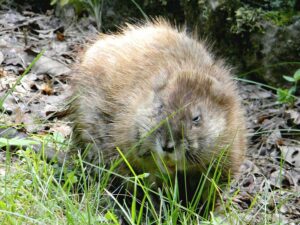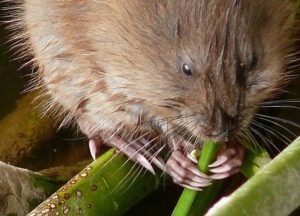Compact mounds of partially dried and decayed plant material can frequently be seen scattered among the cattails and horsetails of marshy landscapes. These dead-looking heaps are homes of the muskrat (Ondatra zibethica), a fairly large rodent found in the wetlands and waterways of Alaska and across North America from the Arctic Ocean in the north to the Gulf of Mexico in the south.
Although the muskrat builds lodges near the water and is an accomplished swimmer, it is not a close relative of the beaver, nor is it a true “rat”. Instead, it is basically a large field mouse that has adapted to life in and around water. The muskrat has a rotund, paunchy appearance. The entire body, with the exception of the tail and feet, is covered with rich waterproof fur. The color ranges from dark brown to light grayish. A full grown animal can weigh about 2 pounds and the length of the body from the tip of the nose to the end of the tail is usually about 20 inches.
The muskrat’s name is derived from the fact that this animal has two special musk glands (also called anal glands) which produces a musky-smelling substance that is deposited at stations along its travel routes. Along with the beaver and several other mammals, the muskrat is capable of remaining submerged up to 15 minutes if in a relaxed state. Non-aquatic mammals cannot do this because they need a continual supply of oxygen and must expel carbon dioxide. The muskrat is able to partially overcome this problem by reducing its heart rate and relaxing its muscles when submerged: this reduces the rate at which oxygen is used. Also, it stores a supply of oxygen in its muscles for use during a dive, and is less sensitive to high carbon dioxide levels in the blood than are non-diving mammals. This ability for extended dives is important in escaping enemies, digging channels and burrows cutting submerged stems and roots, and traveling long distances under the ice.
The front teeth are specially modified for underwater chewing. Non-aquatic mammals such as dogs or humans would have great difficulty in trying to chew on a large object under water, because water would enter the mouth, throat and nasal passages. This problem has been overcome in the muskrat through the evolution of incisors that protrude ahead of the cheeks and of lips that can close behind the incisors. This adaptation permits the muskrat (and the beaver) to chew on stems and roots under water “with its mouth closed”.
A muskrat builds a lodge by first heaping plant material and mud to form a mound. A burrow is then dug into the mound from below the water level, and a chamber is fashioned at the core of the mound. Later, the walls of the lodge are reinforced from the outside with more plants and mud. The mound can be about two to three feet high and two to three feet in diameter. It contains only one chamber and has one or two plunge holes (exit burrows). More complex lodges, containing several separate chambers and plunge holes, may be up to five feet high and six feet in diameter.
Shortly after freeze-up, muskrats chew holes through the ice in bays and channels up to 100 yards away from the lodge to create “push-ups”. After an opening has been created, plant material and mud are used to make a roof over it, like a miniature lodge. Typically, there is just enough room for one muskrat in the push-up. It is used as a resting place during underwater forays, and as a feeding station. During the winter a thick layer of ice restricts the muskrat to the interior of the lodge and the watery environment beneath the ice. The animal’s highly developed diving abilities and its use of push-ups become critical in winter. Foraging trips covering considerable distances, are made under the ice. When the feeding area is reached, portions of plants are chewed off and carried to the nearest push-up, where they are consumed.
Mating activity occurs following spring break-up and the mating pairs do not form lasting family ties, both the males and females are promiscuous. The birth of the litter, containing five to ten young, occurs less than a month after mating. The young at birth are blind, hairless, and almost completely helpless, but develop rapidly. They are covered with thin fur at the end of the first week, their eyes open at the end of the second week, and they normally begin leaving the lodge on short trips at about two to three weeks of age. Weaning occurs at about three weeks and juveniles are essentially independent of their parents at six weeks. The muskrat plays an important role in the trapping industry and in many areas it is an important food item as well. Their main predator (besides humans) is the mink, which occupies much of the same habitat and can be the cause of heavy mortality among juveniles under certain conditions.
Muskrat populations in North America are doing well in spite of heavy trapping pressure, the draining of marshes for agricultural purposes and unprecedented industrial activities. Certainly in Alaska, population numbers today are probably almost as high as they were a thousand years ago.





